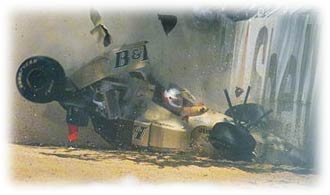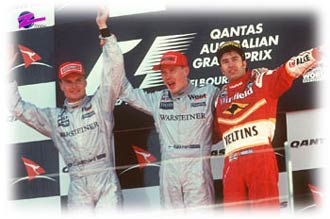|
Race Lap Record: HH Frentzen 1:30.585 (Williams, 1997) Qualifying Lap Record: Jacques Villeneuve 1:29.369 (Williams, 1997)
In 1956, Stirling Moss won the first Grand Prix at Albert Park, in a non-championship race run to coincide with the Olympic Games held in Australia that year. When Victoria won the rights to stage the Grand Prix for 1996, a "new" circuit was designed utilizing portions of the original track, bringing it up to modern F1 specifications. Initially, drivers and team personnel who saw the plans for the renewed circuit, predicted it to be a fast circuit with great corners, but the reality turned out to be somewhat less. However it still stands as one of the better tracks on the calendar, and the atmosphere of the venue is renowned to be matched only by Monaco's.
Like Montreal and Monaco, Albert Park is used only one weekend a year. Therefore, there is a significantly low level of grip in the tarmac. The weekend starts with the track being very 'green', meaning there is lack of rubber on the surface. This is true of all tracks, but more so of the temporary circuits. There is also a problem with dust and debris off-line making the track very difficult if the car should slide. It further makes overtaking very difficult, even though there are some good spots to make an attempt.
A Lap of Albert Park
Past the start/finish line in top gear the cars accelerate under a large walkover bridge reaching close to 290 km/h before hard on the brakes for the first set of turns. Turn 1 is a 3rd gear tight right hander taken in the area of 120 km/h. The exit of the turn 1 becomes turn 2, a long accelerating left hander where the cars will be pulling close to 2.5 gs of lateral load.
Again accelerating to top speed in preparation for turn 3, scene of Martin Brundle's spectacular 1996 incident. It is a sharp right hander taken in 2nd. The drivers keep the car towards the middle of the road on the exit, and need good mechanical grip at the front end to get the car set back to the right for a good run through Turn 4, in 3rd gear across what is a car park the rest of the year.
As the cars track out of Turn 4 the steering wheel is not returned to its central position yet, but lock is kept on. Again the cars must swing quickly over to the other side of the track to get ready for the 4th gear sweeper past the Whiteford grand stand. Down a shaded treelined straight and up into 5th gear. The road weaves from side to side and the cars are kept more or less straight down the middle. They pass the timing stripe as they enter the braking zone at 265 km/h. The road continues to the left slightly but the car is kept straight and level under braking for the upcoming chicane.
Down into 3rd for the first right hander, then immediately up to 4th through the gentle left hander as the road snakes towards the Clark Chicane. From top speed down 4 gears they turn very late and clip the kerb before letting the car swing out and begin the long curved run towards the most critical section of the lap. The road straightens just as they cross the timing stripe for the second split and they have time to go down 1 or 2 gears before flicking the car into the first part of the complex. The elevation of the road changes during this section and the car needs a good aerodynamic balance for stability and exceptional mechanical grip is needed to help the car change direction midcorner. The entry and exit are both at the ends of long straights so how you get through this section really has an impact on your overall lap time.
Out of the complex in 4th gear down another long straight, this time a gradual curve to the right. Down 3 gears and 170 km/h into a 90 degree right. Shifting up into 4th gear the drivers then approach a medium length right hander at the Stewart grand stand. A dab on the brakes to scrub some speed, turn in, apex, and apply power.
As the car runs along the exit kerbing the drivers immediately bring the car back to the right to get ready for the last corner but one. Turn 15 is very much like turn 3, the drivers keeping the car tight in past the apex to get a good run through the final turn. The pit entrance is off to the right and a driver on an in lap will actually go through turn 15 faster than if he was completing a lap. The 2nd gear corner is followed by the last turn, which can be a bit tricky. The road rises just past the apex so good chassis balance is crucial to avoid spinning. They exit the corner in 4th gear and are up to 6th before the timing stripe, to start another lap down under.
Car Setup
Melbourne is a generally smooth circuit so the cars can be run low. Top end is important for the long straight sections between corners. It is equally important to have a good set of gear ratios for optimum acceleration out of the somewhat slow chicanes. As is always the case in race car setup, a compromise is needed. Good mechanical grip at the front end and the ability to turn well while braking is fundamental for the slower corners while aerodynamic balance is most important in the Turn 11-12 section. Good braking efficiency and stability is also crucial for a quick lap at Melbourne.
If you need help with car setup for your racing simulation, please visit the Atlas F1 Racing Simulators forum.
Australia - Trivia Notes
Resume of races in Melbourne 1999 - Eddie Irvine (Britain), Ferrari. The first win of Eddie Irvine's career came after a disastrous start for his rivals after Hakkinen had set pole. The first start was aborted after the Stewarts caught fire -- Herbert missed out while Barrichello started from the pit lane in the spare car. Irvine's Ferrari team mate Michael Schumacher qualified third but started from the back of the grid after stalling before the warm-up. Both McLarens retired. 1998 - Mika Hakkinen (Finland), McLaren. McLaren started the season with a one-two finish and immediate controversy after Coulthard allowed Hakkinen past him two laps from the end. McLaren said they had agreed that whoever led at the first corner would not be challenged by the other. Hakkinen had led but was called into the pit lane due to a "misunderstanding" with his pit crew. The delay allowed Coulthard to take the lead, which he later relinquished. 1997 - David Coulthard (Britain), McLaren Another race of high drama. World champion Damon Hill, who had joined Arrows from Williams, failed to start after a throttle problem. Jacques Villeneuve, who dominated qualifying, was taken out at the first corner by Eddie Irvine's Ferrari. Villeneuve's Williams' team mate Heinz-Harald Frentzen led before spinning off with a brake problem and Coulthard gave McLaren their first victory in 50 outings since Ayrton Senna's win at Adelaide in 1993. 1996 - Damon Hill (Britain), Williams The first outing at Albert Park since the switch from Adelaide. A Williams one-two, with Indy car champion Jacques Villeneuve making an immediate impact in his debut race by leading until engine trouble slowed him down.
|
| Ross Stonefeld | © 2000 Kaizar.Com, Incorporated. |
| Send comments to: intunlim@clearlight.com | Terms & Conditions |

 If you want to read the driving instruction while looking at the map,
If you want to read the driving instruction while looking at the map, 

